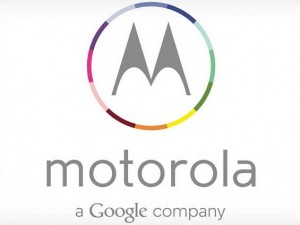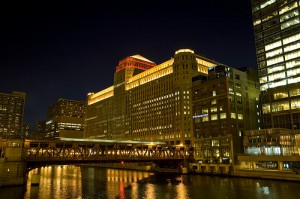Techweek 2013 – Day 1
Originally published on 6/28/2013Every year, Techweek Chicago grows. This year there are over 8000 attendees and actually thousands of companies, ranging from fledgling startups to big tech companies.
Deputy Mayor of Chicago Steve Koch kicked things off talking about how the city government is making a big effort to grow the tech sector, doing things like starting a Bio-Medical Incubator similar to what 1871 is for startups.
Motorola Mobility has a big presence at the conference this year, making a big deal about their return to Chicago, and to the Merchandise Mart the location of Techweek itself. Just the day before Techweek started, they unveiled their new logo and branding, and it is in full effect with the rainbow pastel Google colors replacing the old Moto red.
 **Motorola: Revolutionizing the Move from Libertyville to Downtown** They got right into the talks with Motorola
**Motorola: Revolutionizing the Move from Libertyville to Downtown** They got right into the talks with Motorola Jim Wicks, Motorola Mobility’s SVP of Consumer Experience Design, spoke at length about the future of Chicago as the Tech Hub of the Midwest and the future of communications technology. He ended by saying that even though we are at a technology conference, what we are really talking about is people.
Jim handed it over to Iqbal Arshad, Motorola’s SVP of Engineering, who said he was going to give us the inside scoop on what’s been going on at Motorola since the Google acquisition. He talked about Moto’s previous obsession with putting out lots and lots of products, meeting financial targets and satisfying shareholders. The new vision is not about churning out products as fast as they can, but instead on innovation.
Iqbal touched on the history of computing and the lack of innovation in computer chips and asked, “Are we just building better calculators? Are we solving real human needs, or checking checkboxes?”
He then talked about their new flagship product, Moto X.
Designing Products with Purpose: Fusing Form and Function
After Neal Sales-Griffin and Jason Fried introduced themselves. Together, they do the Starter League, a school with a 9-month graduate level program for people who want to learn programming and has trained over 600 people.
Then they started talking about product design. Jason talked about how when you start you have big ambitions about changing the world. Unfortunately, we always have more ideas than we can implement. It is about paring things down and focusing exclusively on what is essential. Jason has termed this epicenter design. It is about getting things right as you go, before you move on (avoid technical debt!)
You learn what is important as you ship. Software development is based on a lot of guessing. It is important to avoid building too many things on top of those guesses. Shipping your products gets answers.
They talked about hiring. It isn’t just about finding the best people. It is about finding the best people that can work together. It is about creating the best team. Two great people that work together well, can get more done than four great people who don’t.
Jason says he hates the word “content”. You don’t consume “content”, you consume food. “Content” diminishes what you are talking about. You aren’t just filling up space. Words matter. What are you trying to convey? If your company talks about content, then that is what you will deliver. If your company talks about stories or clarity, then that is what it will deliver. Every word you use sets an expectation.
Candid Perspectives On Bootstrapping High Tech Companies US First Robotics Challenge
This was a ‘Fireside Chat’ format led by Maria Katris CEO of Built In. On stage for the discussion were Brandon Cruz (Founder, President, & CTO, GoHealth) Andrew Sieja (Founder & CEO, kCura) and Eric Vassilatos (Co-founder, Vivid Seats). They talked about the early days of bootstrapping their now successful companies. Brandon talked about how they were on the verge of shutting down their business at one point. Andrew talked about experiencing lean years after the dot-com crash. Eric said “Thank god for credit cards.”
Some advice from Andrew to developers who want to become entrepreneurs: “Take a paycut and go into sales for a bit.”
Rise of the Impact Entrepreneur
Chuck Templeton of Impact Engine wasted no time and just started dropping knowledge bombs about building businesses and changing the world at the same time. I took notes as fast as I could:
Solving things at margins instead of at scale. With the population of the Earth reaching 7 billion, we need to change how we think of the world. We have to realize that we now live in a world of finite resources. Instead of materials that glue together, make products that snap together. Moving from a value chain (disposable products) to a value cycle, a market economy to a shared economy, a centralized production model to a distributed mesh model (more resilient), physical products to dematerializations. The big challenges are big opportunities.
The ecology is the foundation of our economy. The next 10 years will be very different from the last 10. New business models are constantly emerging. To get the best people and have the best customers, you need to appeal not just to their pocketbooks and minds, but also their hearts. Chuck finished by talking about two of the startups from the first class of Impact Engine (Azadi and Portapure) that do just that.
How to Create Your Personal Brand Online
This was an interview with about.me Founder & CEO Tony Conrad. Tony talked about the mission of about.me is to be the best way to introduce and define yourself online. It is a problem that people are googling you and then you are defined by an algorhythm. What can an intern talk about on LinkedIn?
For tactical steps, he said first have a starting page to which to point people. Second, be careful to involve yourself in things you want to reflect back on you, and have them link back to that starting page.
They also talked a bit about one of Tony’s companies, Makerbot, which was just acquired for just over $400 million. He compared what is going on at Makerbot to the early days of Apple.
Wearables are the Next Mobile Devices
With over 50+ issued patents to his credit, Rachid Alameh, Tech Lead at Motorola Mobility, was the speaker for this event. He believes wearables will be at the heart of innovation going forward. After covering today’s landscape, he observed that users tend to act with more than one device, choosing one as primary, usually the phone because of its mobility. The interface between devices is manual, where we have to enter credentials and make connections – not a good experience. Wearables will overcome this by offering seamless connections, to even ‘strange’ devices. Password technology will improve (currently people authenticate on their devices 39 times a day).
There will be a fundamental shifts where people will use wearables as their primary device. Our current technology is solid and rigid, but humans are fluid and flexible.
Google Glass takes things to the next level by giving a heads up display and making it hands free. (On a side note, two of the attendees were actually wearing Google Glass)
It is about user experience. The minute you put it on, it customizes and adapts itself to the user. People are creatures of habit. From the moment the wearable is on, it is figuring out these habits and creating a profile. It becomes a digital extension. It does continual background data collection and analysis. It will know where the user is and what he is doing, and adapt itself (a self-grown system) to current conditions.
Wearables must be skin- and body-friendly. We must be able to put them on and forget it. They must operate for extended durations (like watches). These devices will get charged continuously and invisibly throughout the day via heat or energy capture.
There will be strategic sensors. Accelerometers are just one example. There will be optical/proximity sensors. Sensors that detect other devices and make them your own. There are hundreds of uses for these wearables. Rachid presented a few.
Help Me – Wearable detects a fall down stairs. It enables voice command and interacts. If no response, it calls someone relevant to call for help.
Driver Drowsiness – Detects driving conditions. Can even detect who is the driver. It can notice driver drowsiness signals, interact with the user to alert them to the risk.
Early Medical Warning – Can detect health signals, for example a few days in a row of continual sweating, a potential sign of a heart attack.
All Devices Are Mine – Proximity handshakes authenticate users in the background and allow automatic access to personal data anywhere from any device (at a library or mall for example)
All Home Devices To The Rescue – Home devices can monitor health of occupants and spread alerts. For example, allow you to silently check on your children.
Wearables are coming. Make no mistake about it.
Party Time
Next up, I went to the Draftfcb Happy Hour by my company. I got a chance to hang out with some of my coworkers and meet some new people as well.
 Shortly after that, we attended the Motorola “Welcome Home” Party. Luckily the rain stayed away and we got to enjoy listening to the sounds of JC and the Uptown Sound while standing outside on the South Drive alongside the Merchandise Mart, which is quite a [beautiful sight and night][24]! Photo Credit: ifmuth
Shortly after that, we attended the Motorola “Welcome Home” Party. Luckily the rain stayed away and we got to enjoy listening to the sounds of JC and the Uptown Sound while standing outside on the South Drive alongside the Merchandise Mart, which is quite a [beautiful sight and night][24]! Photo Credit: ifmuth